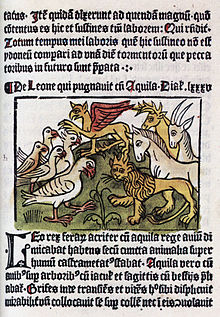Dialogus creaturarum
Dialogus creaturarum optime moralizatus , today mostly referred to in literature as Dialogus creaturarum , is the title of a collection of 122 fables in Latin that was printed in the incunable period and comes from various ancient sources and is presented in the form of dialogues .
The collection and its distribution
Each of the fables of the Dialogus creaturarum is opened in the tradition of the bestiaries with brief references to the respective being and the etymology of its name, then and is in the dialogue of the anthropomorphic creatures, starting with the sun, moon and stars, over the elements to plants and Animals, an event unfolds and this is provided with a moral or anagogical , i.e. eschatological interpretation. In these interpretations, according to the doctrine of the fourfold sense of scripture , general human questions are answered according to the Bible , the Church Fathers or classical philosophy . In the last two fables people also have their say. The author of the collection created around 1400 is unknown; Based on the information in some prints, Maynus de Mayneriis (Mayno de 'Mayneri, a Milanese doctor, † 1376) or Nicolaus Pergamenus / Pergaminus (from Bergamo ) were suspected.
The collection was printed in Latin and provided with woodcuts by Gerard Leeu in Gouda in 1480 ; Leeu published a Dutch version in 1481. Leeu printed further editions of his Dialogus in 1486 and 1491 in Antwerp , where he had moved his office in 1484 . An edition also appeared in Cologne in 1481 . In 1482 Colard Mansion in Bruges translated the work into French and had two manuscripts prepared, one of which is in the Austrian National Library ( Cod. 2572). Johann Snell in Stockholm dated his printing of the collection on December 20, 1483 ; this is provided with colored woodcut illustrations and was the first printed book in Sweden. Another Dutch print Een genoechlick Boeck gheheten dyalogus der creaturen was published by Christaen Snellaert in Delft in 1488. Between 1500 and 1511 further prints appeared in Geneva , Paris and Lyon .
The Lübeck printer Hans van Ghetelen used in his print of Reynke de vos in 1498 some woodcuts from the series of the Stockholm edition, which turned out to be inverted copies of the illustrations that Gerard Leeu had used for his Dialogus prints.
expenditure
- Dialogus creaturarum. Konrad Winters, Cologne 24. X. 1481 ( digitized version ).
- Dialogus creaturarum moralisatus. = Dialogue of the creatures about moral action. Latin-German. Edited, translated and commented by Birgit Esser and Hans-Jürgen Blanke. Königshausen & Neumann, Würzburg 2008, ISBN 978-3-8260-3621-7 .
- Dyalogus creaturarum moralizatus. 1483. = Skapelsens sedelärande samtal. 1483. Commentary: John Bernström; Översätting: Monica Hedlund. Michaelisgillet, Uppsala 1983, ISBN 91-7021-456-5 (facsimile of the woodcut edition by Johann Snell, Stockholm 1483, with Swedish commentary and translation).
literature
- Dieter Lohmeier : Snell, Johann. In: Olaf Klose , Dieter Lohmeier (Hrsg.): Biographical lexicon for Schleswig-Holstein and Lübeck . Volume 10. Wachholtz, Neumünster 1994, ISBN 3-529-02650-6 , pp. 367-369.
Web links
- Works by Magnus de Mayneriis in the complete catalog of incandescent prints
- Proof of prints in WorldCat
- David Kettlewell: Dialogus creaturarum. Renaissance Woodcuts & Fables. (No longer available online.) In: new-renaissance.eenet.ee. Institute of Baltic Studies - Tartu - Estonia, September 17, 2004, archived from the original on February 23, 2014 (English, a selection of the fables in English translation with original illustrations).
Individual evidence
- ↑ Matthis Ilsing, Jos Koldeweij: Jheronimus Bosch - Visions of a Genius. Exhibition catalog. 's-Hertogenbosch 2016, catalog no.81.
- ↑ Amand Berteloot: "Were al dat laken pergement / dat dar worth ghemaket tho Gent, / men scholdet dar nicht in konen schryuen ...". To the prehistory of the "Reynke de Vos". In: Amand Berteloot, Loek Geeraedts, Hubertus Menke (eds.): Reynke de Vos - Lübeck 1498. On the history and reception of a German-Dutch bestseller (= Netherlands studies. Smaller writings 5). Lit, Münster 1998, ISBN 3-8258-3891-9 , p. 18.
